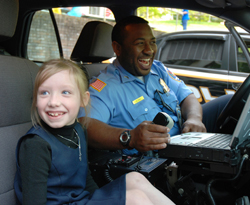 |
|
 |
Event Keeps Getting Better
Earth Day-Take Your Child to Work Day Sets Records |
| By Valerie Lambros |
| |
 |
 |
 |
| |
Savannah Kreider (daughter of Stephanie Kreider, NIAMS) and Cpl. Brian Sims share a laugh. |
It was nearly impossible to miss the droves of children scampering about on Apr. 22, the fourth year in a row that NIH has combined its Earth Day and Take Your Child to Work Day celebrations. It was also hard to miss the smiles on painted faces, the joy of youngsters as they took hold of their very own tree seedlings or the squeals of delight as children experimented with a Geiger counter or tried on police uniforms.
And while children were surely impressed by any one of the 90 activities available on that day, what’s truly remarkable is the day in numbers.
For starters, the NIH community, including
the Bethesda campus and all its satellite locations, welcomed more than 3,300 children.
That’s almost 500 more than attended last year.
more…
|
|
|
Pharmacogenomics and Alcoholism
Why Meds Work for Some People, but Not for Others |
| By Valerie Lambros |
|
You can add alcoholism
to the growing
list of conditions
that may be addressed with medication,
depending on a patient’s genetic topography.
That was the message delivered recently in a lecture by NIAAA clinical director Dr. Markus Heilig, who studied the effect—or lack thereof—of the drug naltrexone (an opioid antagonist commonly
used in the treatment of drug addiction) on a person’s wired desire to reach for a drink. It appears as though people struggling with alcoholism for whom naltrexone is an effective treatment possess a particular genetic variant. That variant is worked on by the drug to stymie its push to make the body want alcohol.
more…
|
|
|
|
|
 |

